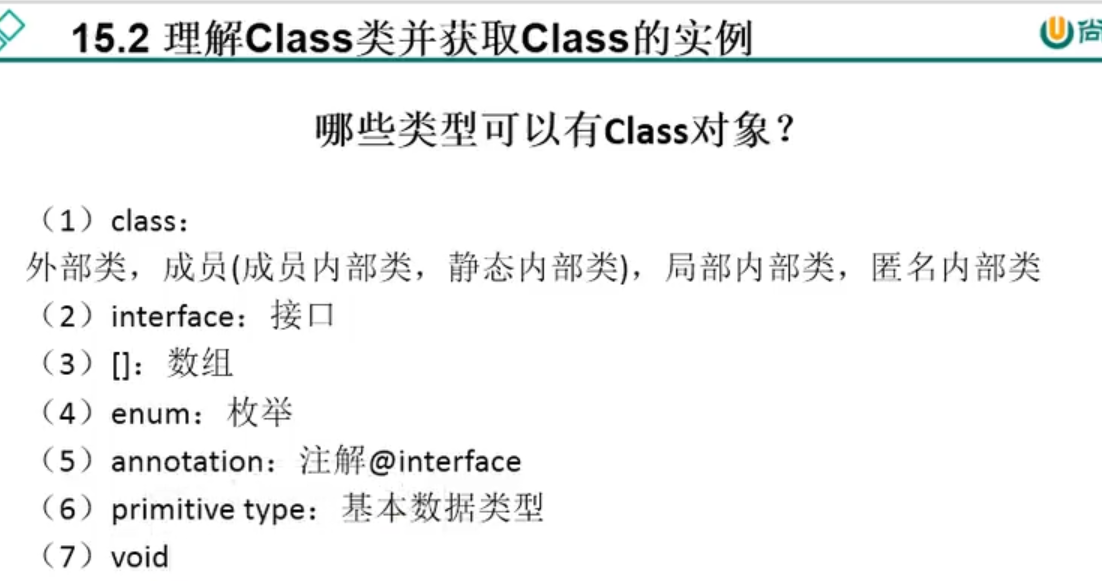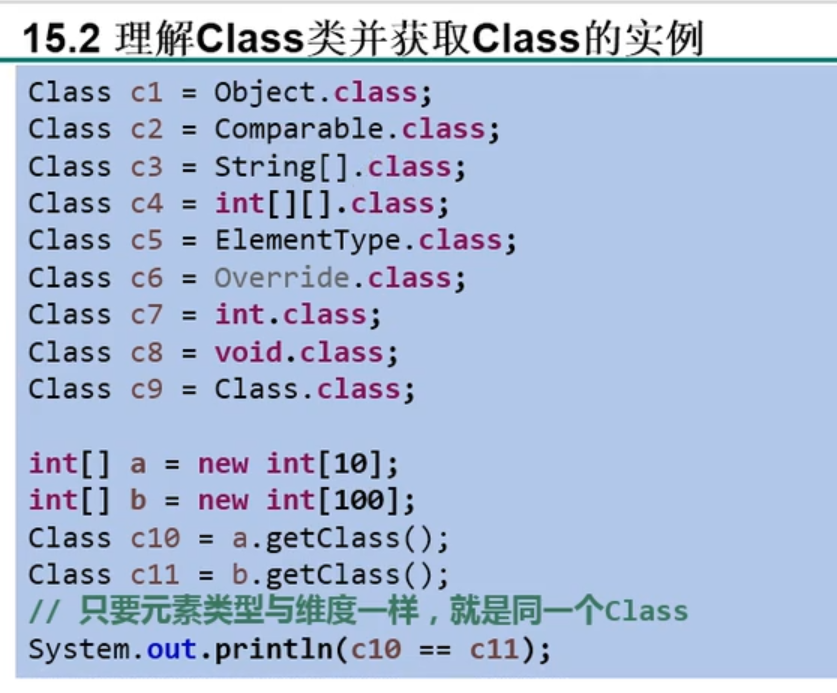

/*
关于java.lang.Class类的理解
1.类的加载过程:
程序经过javac.exe命令以后,会生成一个或多个字节码文件(.class结尾)。
接着我们使用java.exe命令对某个字节码文件进行解释运行。相当于将某个字节码文件加载到内存中。此过程就称为类的加载。加载到内存中的类,我们就称为运行时类,此运行时类,就作为Class的一个实例。
2.换句话说,Class的实例就对应着一个运行时类。
3.加载到内存中的运行时类,会缓存一定时间。在此时间之内,我们可以通过不同的方式来获取此运行时类。
package com.atguigu.java1;import org.junit.Test;import java.lang.annotation.ElementType;import java.lang.reflect.Constructor;import java.lang.reflect.Field;import java.lang.reflect.Method;/*** @author Dxkstart* @create 2021-06-06 19:26*/public class ReflectionTest {//反射之前,对于Person的操作@Testpublic void test1(){//1.创建Person类的对象Person p1 = new Person("Tom", 12);//2.通过对象,调用其内部的属性、方法p1.age = 10;System.out.println(p1.toString());p1.show();//在Person类的外部,不可以通过Person类的对象调用其内部私有的结构。//比如:name、showNation()以及私有的构造器}//反射之后,对于Person的操作@Testpublic void test2() throws Exception {Class clazz = Person.class;//1.通过反射,创建Person类的对象Constructor cons = clazz.getConstructor(String.class, int.class);Object obj = cons.newInstance("Tom", 14);Person p= (Person)obj;System.out.println(p.toString());//2.通过反射,调用对象指定的属性、方法//调属性Field age = clazz.getDeclaredField("age");age.set(p,10);System.out.println(p);//调方法Method show = clazz.getDeclaredMethod("show");show.invoke(p);System.out.println("*************************");//通过反射,可以调用Person类的私有结构的。比如:私有的构造器、方法、属性//调用私有的构造器Constructor cons1 = clazz.getDeclaredConstructor(String.class);cons1.setAccessible(true);Person p1 = (Person)cons1.newInstance("Jerry");System.out.println(p1);//调用私有的属性Field name = clazz.getDeclaredField("name");name.setAccessible(true);name.set(p1,"泰勒");System.out.println(p1);//调用私有的方法Method showNations = clazz.getDeclaredMethod("showNation", String.class);showNations.setAccessible(true);String nation = (String) showNations.invoke(p1,"中国");//相当于String str = p1.showNation("中国")System.out.println(nation);}//疑问1:通过直接new的方式或反射的方式都可以调用公共的结构,开发中到底用哪个?//建议:直接new的方式。//什么时候会使用:反射的方式。反射的特征:动态性//疑问2:反射机制与面向对象中的封装性是不是矛盾的?如何看待两个技术?//不矛盾。/*关于java.lang.Class类的理解1.类的加载过程:程序经过javac.exe命令以后,会生成一个或多个字节码文件(.class结尾)。接着我们使用java.exe命令对某个字节码文件进行解释运行。相当于将某个字节码文件加载到内存中。此过程就称为类的加载。加载到内存中的类,我们就称为运行时类,此运行时类,就作为Class的一个实例。2.换句话说,Class的实例就对应着一个运行时类。3.加载到内存中的运行时类,会缓存一定时间。在此时间之内,我们可以通过不同的方式来获取此运行时类。*///获取Class的实例的方式(前三种方式需要掌握)@Testpublic void test3() throws ClassNotFoundException {//方式一:调用运行时类的属性:.classClass<Person> clazz1 = Person.class;System.out.println(clazz1);//方式二:通过运行时类的对象,调用getClass()Person p1 = new Person();Class clazz2 = p1.getClass();System.out.println(clazz2);//方式三(常用的):调用Class的静态方法:forName(String classPath)Class clazz3 = Class.forName("com.atguigu.java1.Person");System.out.println(clazz3);System.out.println(clazz1 ==clazz2);System.out.println(clazz1 ==clazz3);//方式四:使用类的加载器:ClassLoader (了解)ClassLoader classLoader = ReflectionTest.class.getClassLoader();Class clazz4 = classLoader.loadClass("com.atguigu.java1.Person");System.out.println(clazz4);System.out.println(clazz1 == clazz4);}//Class实例可以是哪些结构的说明:@Testpublic void test4(){Class c1 = Object.class;Class c2 = Comparable.class;Class c3 = String.class;Class c4 = int[][].class;Class c5 = ElementType.class;Class c6 = Override.class;Class c7 = int.class;Class c8 = void.class;Class c9 = Class.class;int[] a = new int[10];int[] b = new int[100];Class c10 = a.getClass();Class c11 = b.getClass();//只要数组的元素类型与维度一样,就是同一个ClassSystem.out.println(c10 == c11);//true}}
package com.atguigu.java1;/*** @author Dxkstart* @create 2021-06-06 19:26*/public class Person {private String name;public int age;public Person(){}public Person(String name,int age){this.name = name;this.age = age;}//private Person(String name){this.name = name;}public String getName(){return name;}public void setName(String name){this.name = name;}public int Age(){return age;}public void setAge(int age){this.age = age;}@Overridepublic String toString() {return "Person{" +"name='" + name + '\'' +", age=" + age +'}';}public void show(){System.out.println("你好,我是一个人");}private String showNation(String nation){System.out.println("我的国籍是:" + nation);return nation;}}

